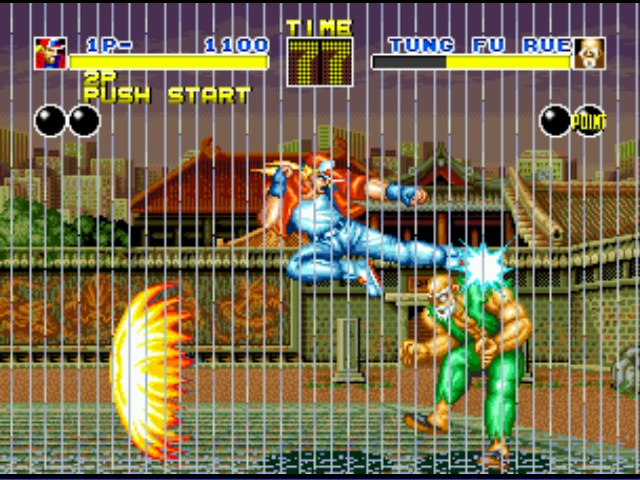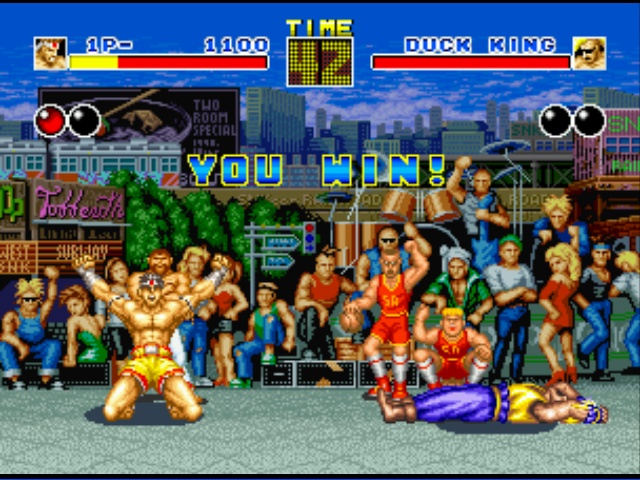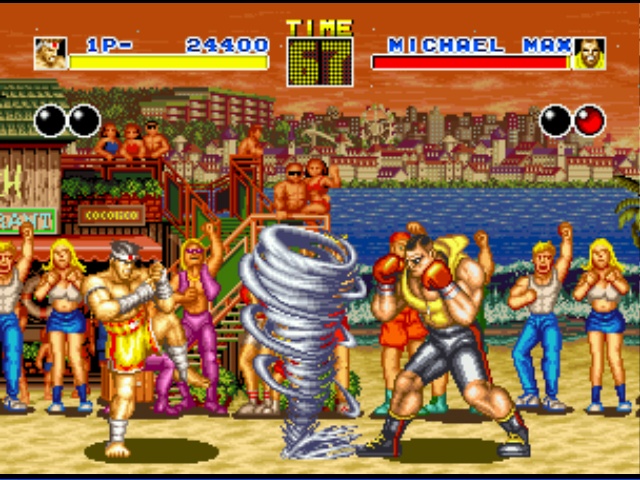2D arcade fighting games were popularized by Capcom's Street Fighter II back in the 1990s, but there were other pretenders to the throne, including SNK's Fatal Fury series. You know the deal with these games: You'd pick a character, usually a martial artist of some sort, and then fight one-on-one battles against other martial artist characters, usually on a colorful background, while your character and your opponent's character shouted the names of their mighty special techniques aloud, just like the heroes of many Japanese cartoons. The Fatal Fury series started in 1991, and over the next four years, it gave rise to the four games in this collection: the original Fatal Fury, Fatal Fury 2, Fatal Fury Special, and Fatal Fury 3: Road to the Final Victory, all of which are emulated more or less flawlessly. Fatal Fury Special is the standout game of the collection because of its solid, old-fashioned gameplay, but with the way these games look and feel, you'll probably have to be a fighting-game historian or devoted SNK fan to really get much from this collection.

The NeoGeo hardware was home to many 2D arcade games for more than a decade. SNK was the creator of both the hardware and the majority of the games. Over those years, its development teams became more familiar with the NeoGeo and what it could do, and they gradually produced better-looking, better-sounding games. You can really see this progression in this collection, and you can also see why the Fatal Fury series was well on its way to becoming SNK's flagship fighting series. It produced some of the company's most memorable characters and rivalries (at least until the developer's true flagship series, The King of Fighters, emerged in 1994). Aside from introducing characters that are still remembered today and that still appear in KOF games, the series' other claim to fame was its unusual "plane-based" gameplay that split the background into multiple fighting planes. Your character and your opponent could hop back and forth between these planes, which sort of gave the illusion of 3D gameplay before 3D games really existed. However, even though it appeared in one form or another throughout most of the series, the plane system never really came into its own, and was eventually dropped in the final Fatal Fury game from SNK, 1999's Mark of the Wolves.
Unfortunately, this collection starts with the very early phases of NeoGeo development: the original Fatal Fury. It's sad but true that the first game in the series truly is primitive by today's standards. It doesn't have any of the accoutrements you'd expect from a fighting game in this day and age. There are no powerful "superattacks," only one type of normal punch and normal kick attack, no real combination attacks, and a selection of only three playable characters. The game's one unique feature is its ability to let two players fight a single opponent at the same time, years before Capcom's Street Fighter Alpha series offered the same kind of option as a dramatic battle mode. Unfortunately, this feature doesn't really add anything to the game. Otherwise, the original Fatal Fury's muffled voice samples, crude presentation, and sluggish pace won't do much to win you over. Unless you're a fanatical fan or an obsessive completist, the original Fatal Fury probably won't have much to offer you beyond a history lesson.
Business picked up with 1992's Fatal Fury 2, a sequel that brought back the first game's three heroes and pitted them against an all-new cast of characters, like the femme fatale Mai Shiranui and the Korean martial artist Kim Kaphwan, all of whom were playable. Even though the game still looks quite dated by today's standards, Fatal Fury 2 has much better presentation, with more-complex character sprites, better special effects, and scrolling background stages that look much more interesting. The audio is also much improved; each background stage has significantly memorable music, and the characters' voices and the game's special effects sound much louder and clearer. The game also offers an expanded and more-responsive control scheme with two types of punches and kicks, and an improved implementation of the plane-attack idea that lets you freely jump between the two planes, foreground and background, as well as knock your enemies into another plane. The sequel also has a slightly faster pace, and introduces SNK's infamous desperation-move attacks--devastating superattacks that can only be performed once your character's health has been severely depleted. Fatal Fury 2, as it is, is a pretty decent if not particularly modern game, and might've been worth a second look for fighting-game enthusiasts looking to brush up on their history, if this collection didn't also contain Fatal Fury Special.

Fatal Fury Special, originally released in 1993, is a tweaked version of Fatal Fury 2 that makes the game's boss characters playable, speeds up the pace slightly, and makes the gameplay more conducive to combination attacks, as well as to link combinations (combinations of normal attacks strung together with proper timing). Some minor tweaks were made to the game's presentation, but overall, it still looks like a very old game, and its pacing may seem too slow for newer fighting-game fans who cut their teeth on the fighting games of the late 1990s and early 21st century.
However, if you can get past the dated presentation, you'll find a game with a lot of personality--this was one of the first fighting games in which developer SNK really started to emphasize humor and hidden Easter egg details, hiding cameo appearances by other characters and running sight gags (such as schools of walking rubber ducks, a play on one of the characters, Duck King). The high-level game offers a surprisingly sophisticated experience, in which players carefully bob and weave until they can unload with complicated link-combination attacks that deal lots of damage and often cause their opponents to become momentarily stunned. Just be careful when playing in single-player mode, given that the original game was notorious for having some of the most insanely tough computer-controlled opponents ever--a fact that hasn't changed in this perfectly emulated collection. If you're a serious and open-minded fan of fighting games, you could probably find yourself wiling away a few afternoons with this game; if you're a nostalgic SNK fan, this perfectly emulated version of Fatal Fury Special may feel like coming home again.
The last game in the collection is 1995's Fatal Fury 3: Road to the Final Victory, an odd, transitional game that would give way to three more-evolved Fatal Fury sequels in later years. SNK was an adventurous game developer, and with this game, it threw most of the series' foundations out the window and presented a new game with a brand-new graphical presentation and a confusing new gameplay system that offered three different fighting planes (foreground, center, and background). It also included a handful of new characters, like the blonde private investigator Blue Mary, as well as the zany, dreadlocked Rastafarian fighter Bob Wilson. The game also unveiled a new chain-combination system that let certain characters unleash strings of normal attacks with the correct button combinations, plus a bizarre, enhanced desperation-move system, which required you to enter a code before a match would begin.

Fatal Fury 3 was definitely a pretty radical departure from Fatal Fury Special, and its faster pace and stronger emphasis on combination attacks may make it seem more playable to modern fighting-game enthusiasts. Nevertheless, players who didn't play the original game will probably find the three-plane gameplay confusing because it requires different combinations of button presses to switch to different planes, and also to attack enemies who have slid over to another plane. You can see the foundations for a really interesting and deep fighting game in Fatal Fury 3, but it doesn't really come together into a cohesive whole. It took SNK a few more years, and three other sequels that built on what Fatal Fury 3 established, to refine the gameplay. Unfortunately, those other sequels don't appear in this collection.
Aside from the flawless emulation of the games and the ability to switch between the game's arcade music and its arranged soundtrack (which appeared on the NeoGeo CD home console versions of these games), this collection also offers a throwaway color-edit feature that lets you recolor character sprites in the games if you care to. Unfortunately, that's it; just like SNK's Art of Fighting Anthology, this collection offers no real extras, even though Fatal Fury arguably has an even richer history as a series. Among other things, SNK could've included the series' hilarious Japanese TV commercials or hidden the 1994 animated Fatal Fury movie on the disc, but no such luck. The bottom line is that this collection really provides the games and only the games. If you're an SNK devotee or a serious fighting game connoisseur, you might enjoy the collection as a nostalgia piece or as an opportunity to revisit Fatal Fury Special. If you're more of a casual fighting-game fan, you might be better off waiting for the second Fatal Fury Battle Archives collection, which features the three games that came after Fatal Fury 3, or looking for a Dreamcast copy of the series' crown jewel, Mark of the Wolves.